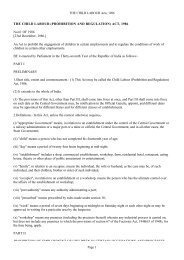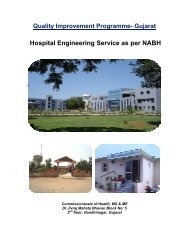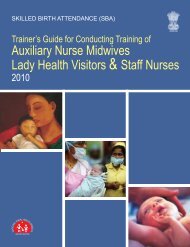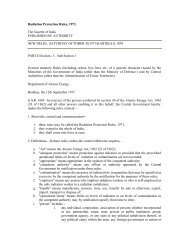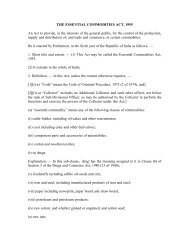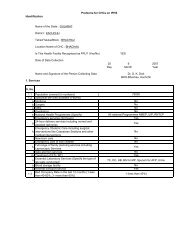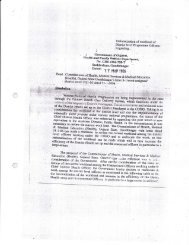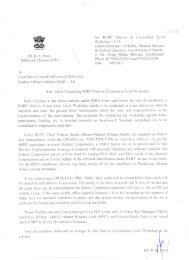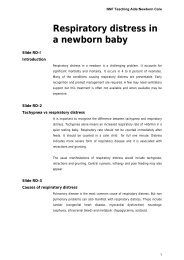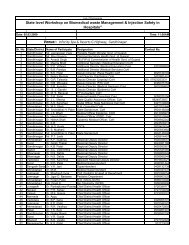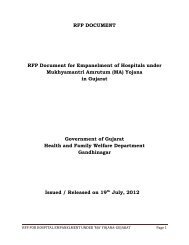I Bench aids for malaria microscopy
I Bench aids for malaria microscopy
I Bench aids for malaria microscopy
You also want an ePaper? Increase the reach of your titles
YUMPU automatically turns print PDFs into web optimized ePapers that Google loves.
nch <strong>aids</strong> <strong>for</strong>
<strong>Bench</strong> <strong>aids</strong> <strong>for</strong> <strong>malaria</strong> microswpl<br />
Contents<br />
Plate 1 i<br />
world H eg<br />
Organizat -<br />
d<br />
Pl&2 llb
- -<br />
<strong>Bench</strong> <strong>aids</strong> <strong>for</strong> <strong>malaria</strong> microscop!<br />
Uk cycle of <strong>malaria</strong><br />
mm<br />
ulYk*<br />
-
<strong>Bench</strong> <strong>aids</strong> <strong>for</strong> <strong>malaria</strong> microscop<br />
Plate 2a<br />
htroductiom<br />
cdk, a d the cycle reawms. Fever<br />
of ~ed c&. hptith oftho cy&
-<br />
<strong>Bench</strong> <strong>aids</strong> <strong>for</strong> <strong>malaria</strong> microscop<br />
Plate 2b
<strong>Bench</strong> <strong>aids</strong> <strong>for</strong> <strong>malaria</strong> microscorn Plate 3:<br />
Labmh-ks should tdbw mtimd safsty guiddha k d on<br />
~~ etddihed stmda&. Mmd sam+ must be<br />
c d d pobntdy inktiow, d ldwx&ory .stdshdd be<br />
trained in setting up a d -=<br />
a d guddines, a ugis:<br />
torysu#m*.<br />
11. cd wd 1;~~h~ets a d camind needles ad<br />
rnatesharp<br />
ccsntaisler.<br />
12. Clean w d s&s at the d af each warking day with an<br />
d-pur- ~ n a;uch M hypochlorite ~ t dution at a<br />
ccmantr&im ofO.l% wailde &larim (1 gll).<br />
13. Do wt eat or drink m y f m areas; making<br />
'tdWddmhalM.<br />
14. Restrict access b the ldmmbry to authorized p amd.<br />
1. Ifding the paitieds MI hslad pah ~~, skt the<br />
third fmthhd.Usetheb%gtoehri~hish<br />
never the thud fix chikdmn tx hks.<br />
R e m grease and dirt by ckanimg the ball of the 6-<br />
~ ~ ~ d ~ p Y ~ k e r l h 7 ~ ~ r v<br />
Use &rn strokes to stimuhe W chc-, d dry the<br />
6qer with a chn cotton cloth.<br />
2. With a &mile lancet, puncture the bell oA the fi-r w&h a<br />
quidr rabg action.<br />
Expa the first drop of Mood id w@e it off with dry cottm<br />
d. Engure that rzo cotton strancls remain on the finger<br />
." to later mix with the Mood.<br />
3. Handle slides only by the edges, work quiddy to calk ttke<br />
hod: apply gentle pmwre to the fiqer ad<br />
cdlect a sin&<br />
drop ofW, aht this size a, on the middie of tlae &&.<br />
Express three larger dmp of W, &wt this size a, d<br />
place them about 1 all ~m<br />
thin film.<br />
tk e p ths<br />
Wipe the remaining W away, and apply pewre to the<br />
puncture to stop tke bkd k.<br />
4. 'Wimre.Ushga&ansliclezsa'<br />
dide with blood resting an a @at, fir<br />
small drop olf blood with the e(e<br />
bhd runs dong its edge. Firmly<br />
sprezbder along the sw!<br />
angle of 45"; emure that<br />
with tke surface of the slide.<br />
5. 'LhMr fik To makg<br />
tkedg,eserbq.acm<br />
quddyjoin the dmps d<br />
an wen, thick film.A d<br />
rectangdar film can be<br />
rnmmmmb. Circular hi& &h<br />
diameter.
<strong>Bench</strong> <strong>aids</strong> <strong>for</strong> <strong>malaria</strong> <strong>microscopy</strong> Plate 3b ..<br />
-<br />
w<br />
0"-<br />
Qrganiza<br />
-& Bn @&<br />
@@tic banam- ur<br />
&Me they ap$oa rsqlndle-shaped bodies, the red cell membrane is often difficl b am<br />
Ded bodiao rrllk naunded ends (m-o) Macroqametocytes have blue cytoplasm, ud #RIB
I <strong>Bench</strong> <strong>aids</strong> <strong>for</strong> <strong>malaria</strong> <strong>microscopy</strong><br />
plate 4a<br />
ca slides<br />
- -<br />
Common faults in making blood films
sencn <strong>aids</strong> tor <strong>malaria</strong> <strong>microscopy</strong><br />
IasrnudWm fa/cipamrn thick film.<br />
* Iw.wirvprzlMlhrg&M~~<br />
mmphdogical ~WQEJS in g~~ that make a definite diagnosis of the stage dicd (A). Mixed infections may be mm common during the Brnsmhrsion seasol
-<br />
1 <strong>Bench</strong> <strong>aids</strong> <strong>for</strong> <strong>malaria</strong> micrmc~py &< '<br />
. Plate 5a<br />
z<br />
Y. rl mre of the m~roscope<br />
-<br />
-<br />
in- .<br />
thr .
Vasmodiun, dvw thin film<br />
Trophozoibs. It IS difficult to differentiate species when only the ring stage is present. In each of a, b and c, the infected red cells are not enlarged, then o SchW<br />
Oppllng, and there are no amoeboidfmm. Each of these characteristics helps in diagnosing F! vim infection. Confirnation requires further examination .s fikn and<br />
Hmlifkakn af W F? Ws?qgs. OY\sr &ges and the presence of rings, as in a, b and c, might suggest a mixed F! fakipam and P vivavinfection. Double infecticiner<br />
would want to ensure that this is F! viwand not F! ode by continued examin<br />
awd<br />
Ilk<br />
!rn<br />
gchizonts. IniWy larw and amoeboid, the typical scWt d i quickly im an irregular mass, farmjng 12-24 rmmmki. Each fnmmb b roPnpo63ed of a a d ma%<br />
& blue-&ining c ~ and a ~ diwete m dot of I'M chromiin. Schiifffiaf d~pI'ig is wident, and pigment gathers into one or two md irrwr clmm 0.<br />
b y Often diff~culto d~st~ngu~sh from mature trophozo~tes, gametocytes usually have a reguli und outlln I blood cell conUning a gmwbcyt<br />
$rpiially enlarged, with prominent SchW<br />
swing (m,n). Macrogametocytes (m,@ kge and prmnm Mue, wtth a small, compact chromatin mass that staKO<br />
I very deep dads& (W) -g with a Fit blue cm- tha~ m s to @in g2@ef~d gm&i<br />
Mgment.
<strong>Bench</strong> <strong>aids</strong> <strong>for</strong> <strong>malaria</strong> <strong>microscopy</strong><br />
-<br />
buff^ solutions <strong>for</strong> staining <strong>for</strong> <strong>malaria</strong> parasites
I <strong>Bench</strong> <strong>aids</strong> <strong>for</strong> <strong>malaria</strong> <strong>microscopy</strong><br />
Plate 6t<br />
lasmodium vivax thick film
lench <strong>aids</strong> <strong>for</strong> <strong>malaria</strong> <strong>microscopy</strong> 'late 72<br />
World Heal&<br />
- - Organizatim<br />
Giemsa staining of <strong>malaria</strong> parasites in blood films<br />
Staining results<br />
w*<br />
&%€<br />
Preparation of stock Giemsa solutim
encn alas tor <strong>malaria</strong> mlcroscop<br />
, re-
-<br />
<strong>Bench</strong> <strong>aids</strong> fc <strong>malaria</strong><br />
Giemsa staining of mama parasites in blRd films<br />
World Health<br />
Organization<br />
$aining results<br />
w*<br />
Wmsapid (10%) method<br />
. Zt
hfil iaktim, k t this is di&ult to monitor in areas where<br />
trmsrnkkm L cmtbslt.<br />
Maq ycwtqg riq i+xrns are usual$ men in the thick film; p-
-<br />
1 <strong>Bench</strong> <strong>aids</strong> <strong>for</strong> <strong>malaria</strong> micmqq Plate 81<br />
'lasmodium <strong>malaria</strong>e fhick fill<br />
a<br />
ti-
lench <strong>aids</strong> <strong>for</strong> <strong>malaria</strong> <strong>microscopy</strong> 'late 92<br />
Routine examination of blood f-<br />
<strong>for</strong> <strong>malaria</strong> parasites<br />
counting <strong>malaria</strong> parasites in<br />
thick blood films<br />
*<br />
Figure 2. Thin film examin-<br />
I 1<br />
Method 2
<strong>Bench</strong> <strong>aids</strong> <strong>for</strong> <strong>malaria</strong> microsc<br />
Plasmodhm ovale thin film<br />
b... Plate 9b<br />
Tqhoaoites. Like P viva, P ovale favours young red cells, and early trophozoites are virtually indistinguishable from those in other species (a,b); cellular en<br />
the presence of stippling quickly alters this (c-e). The oval shape of P ovale that gives the species its name can occur quite early with trophozoites but is due Iiw@&y bthe<br />
blood film conditions. The description of P ovaleas 'a <strong>malaria</strong>e-like parasite in a viva-like red cell' is helpful (see d-g,i,j), although the modest enlargement d<br />
cells in P ovale is seldom stressed. Parasites have a dense chromatin with fewer amoeboid <strong>for</strong>ms (f). Fimbriation of the red cell is often a deciding diagnostic factw (h,l).<br />
Schizonts. Schizonts are easily recognized by the clarity of staining and separation between the merozoites, the modest cellular enlargement, frequent P ovale shapes and<br />
Schiiffner stippling (i-k,l). The number of merozoites is between 6 and 12 but can reach 18. Pigment collects in small clumps in the centre of the schizont's mass.<br />
Gametocytes. Differences d P s the enlarged red<br />
cell, while the irregular mag bra m, which later <strong>for</strong>m a<br />
dark-brown mass with a greenish tinge. In well-stained thin films, Schiiffner stippling clearly shows bead-like, pink-staining granules.
<strong>Bench</strong> <strong>aids</strong> <strong>for</strong> <strong>malaria</strong> <strong>microscopy</strong><br />
I<br />
mid staining of blood filmzor <strong>malaria</strong> parasites<br />
vwdm<br />
Organization
Plate lob
1 <strong>Bench</strong> <strong>aids</strong> <strong>for</strong> <strong>malaria</strong> microscow ate 11;
<strong>Bench</strong> <strong>aids</strong> <strong>for</strong> <strong>malaria</strong> <strong>microscopy</strong><br />
11
1 <strong>Bench</strong> <strong>aids</strong> h
<strong>Bench</strong> <strong>aids</strong> <strong>for</strong> <strong>malaria</strong> <strong>microscopy</strong> 'late 12b<br />
@<br />
Organiza<br />
hrH Hea<br />
gf W- or kw-beme<br />
lWytrs seen I~I pernerd Mood fillr~s (r --owed, thick film and c, thin film) and may be present with




